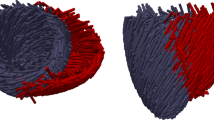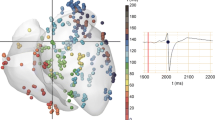Abstract
The origin of the multiple, complex morphologies observed in unipolar epicardial electrograms, and their relationships with myocardial architecture, have not been fully elucidated. To clarify this problem we simulated electrograms (EGs) with a model representing the heart as an anisotropic bidomain with unequal anisotropy ratio, ellipsoidal ventricular geometry, transmural fiber rotation, epi-endocardial obliqueness of fiber direction and a simplified Purkinje network. The EGs were compared with those directly recorded from isolated dog hearts immersed in a conducting medium during ventricular excitation initiated by epicardial stimulation. The simulated EGs share the same multiphasic character of the recorded EGs. The origin of the multiple waves, especially those appearing in the EGs for sites reached by excitation wave fronts spreading across fibers, can be better understood after splitting the current sources, the potential distributions and the EGs into an axial and a conormal component and after taking also into account the effect of the reference or drift component. The split model provides an explanation of humps and spikes that appear in the QRS (the initial part of the ventricular EG) wave forms, in terms of the interaction between the geometry and direction of propagation of the wave front and the architecture of the fibers through which excitation is spreading. © 2000 Biomedical Engineering Society.
PAC00: 8719Nn, 8710+e, 8719Hh
Similar content being viewed by others
REFERENCES
Colli Franzone, P., and L. Guerri. Spreading of excitation in 3D models of the anisotropic cardiac tissue. I: Validation of the eikonal model. Math. Biosci. 113:145-209, 1993.
Colli Franzone, P., M. Pennacchio, and L. Guerri. Accurate computation of electrograms in the left ventricular wall. Math. Mod. Meth. Appl. Sci. M 3 AS. 10:507-538, 2000.
Colli Franzone, P., L. Guerri, M. Pennacchio, and B. Tac-cardi. Spread of excitation in 3D models of the anisotropic cardiac tissue. II: Effects of fiber architecture and ventricular geometry. Math. Biosci. 147:131-171, 1998.
Colli Franzone, P., L. Guerri, M. Pennacchio, and B. Tac-cardi. Spread of excitation in 3D models of the anisotropic cardiac tissue. III: Effects of ventricular geometry and fiber structure on the potential distribution. Math. Biosci. 151:51-98, 1998.
Fast, V. G., and A. G. Kleber. Role of wavefront curvature in propagation of cardiac impulse. Cardiovasc. Res. 33:258-271, 1997.
Geselowitz, D. B., R. C. Barr, M. S. Spach, and W. T. Miller III. The impact of adjacent isotropic fluids on electrocardio-grams from anisotropic cardiac muscle. A modeling study. Circ. Res. 51:602-613, 1982.
Geselowitz, D. B. On the theory of the electrocardiogram. Proc. IEEE 77:857-876, 1989.
Green, L. S., B. Taccardi, P. R. Ershler, and R. L. Lux. Epicardial potential mapping: effect of conducting media on isopotential and isochrone distributions. Circulation 84:2513-2521, 1991.
Gulrajani, R. M. Models of the electrical activity of the heart and computer simulation of the electrocardiogram. Crit. Rev. Biomed. Eng. 16:1-66, 1988.
Henriquez, C. S. Simulating the electrical behavior of cardiac tissue using the bidomain model. Crit. Rev. Biomed. Eng. 21:1-77, 1993.
Henriquez, C. S., A. L. Muzikant, and C. K. Smoak. Anisot-ropy, fiber curvature, and bath loading effects on activation in thin and thick cardiac tissue preparations: Simulations in a three-dimensional bidomain model. J. Cardiovasc. Electro-physiol 7:424-444, 1996.
Leon, L. J., and B. M. Horacek. Computer model of excita-tion and recovery in the anisotropic myocardium, I: Rectan-gular and cubic arrays of excitable elements. II: Excitation in the simplified left ventricle III: Arrhythmogenic conditions in the simplified left ventricle. J. Electrocardiol. 14:1-15,17-31,33-41, 1991.
MacLeod, R. S., and C. R. Johnson. Map3d: Interactive sci-entific visualization for bioengineering data. IEEE Engineer-ing in Medicine and Biology Society 15th Annual Interna-tional Conference. New York: IEEE, 1993, pp. 30-31.
Oster, H. S., B. Taccardi, R. L. Lux, P. R. Ershler, and Y. Rudy. Electrocardiographic imaging: Noninvasive character-ization of intramural myocardial activation from inversely-reconstructed epicardial potentials and electrocardiograms. Circulation 97:1496-1507, 1998.
Punske, B. B., R. L. Lux, R. S. MacLeod, P. R. Ershler, T. J. Dustman, Y. Vyhmeister and B. Taccardi. Experimental study and removal of the drift of the reference potential from the unipolar electrogram. First joint meeting of BMSE and IEEE EMBS Atlanta, Georgia, 13-16 October 1999.
Roberts, D. E., and A. M. Scher. Effect of tissue anisotropy on extracellular potential fields in canine myocardium in situ. Circ. Res. 50:342-351, 1982.
Roth, B. J. Action potential propagation in a thick strand of cardiac muscle. Circ. Res. 68:162-173, 1991.
Simms, H. D., and D. B. Geselowitz. Computation of heart surface potentials using the surface source model. J. Cardio-vasc. Electrophysiol 6:522-531, 1995.
Spach, M. S., W. T. Miller III, E. Miller-Jones, R. B. Warren, and R. C. Barr. Extracellular potentials related to intra-cellular action potentials during impulse conduction in aniso-tropic canine cardiac muscle. Circ. Res. 45:188-204, 1979.
Spach, M. S., W. P. Silberberg, J. P. Boineau, R. C. Barr, E. Croft Long, T. M. Gallie, J. B. Gabor, and A. G. Wallace. Body surface isopotential maps in normal children, ages 4 to 14 years. Am. Heart J. 72:640-652, 1966.
Taccardi, B., R. L. Lux, P. R. Ershler, T. D. Dustman, M. Scott, Y. Vyhmeister, and N. Ingebrigtsen. Effect of myocar-dial fiber direction on 3D shape of wavefronts and associated potential distributions in the ventricular wall. Circulation 86:I-752, 1992.
Taccardi, B., R. L. Lux, R. S. MacLeod, P. R. Ershler, T. D. Dustman, M. Scott, Y. Vyhmeister, and N. Ingebrigtsen. Electrocardiographic waveforms and cardiac electric sources. J. Electrocardiol. 29:98-100, 1996.
Taccardi, B., E. Macchi, R. L. Lux, P. R. Ershler, S. Spag-giari, S. Baruffi, and Y. Vyhmeister. Effect of myocardial fiber direction on epicardial potentials. Circulation 90:3076-3090, 1994.
Taccardi, B., S. Veronese, P. Colli Franzone, and L. Guerri. Multiple components in the unipolar electrocardiogram: A simulation study in a three-dimensional model of ventricular myocardium. J. Cardiovasc. Electrophysiol 9:1062-1084, 1998.
Wilson, F., A. Macleod, and P. Barker. The distribution of the action current produced by the heart muscle and other excitable tissues immersed in extensive conducting medium. J. Gen. Physiol. 16:523-556, 1933.
Yan, G. X., and C. Antzelevitch. Cellular basis for the elec-trocardiographic J wave. Circulation 93:372-379, 1996.
Author information
Authors and Affiliations
Rights and permissions
About this article
Cite this article
Franzone, P.C., Guerri, L., Pennacchio, M. et al. Anisotropic Mechanisms for Multiphasic Unipolar Electrograms: Simulation Studies and Experimental Recordings. Annals of Biomedical Engineering 28, 1326–1342 (2000). https://doi.org/10.1114/1.1327595
Issue Date:
DOI: https://doi.org/10.1114/1.1327595




